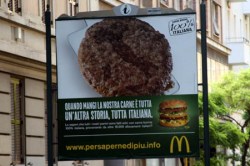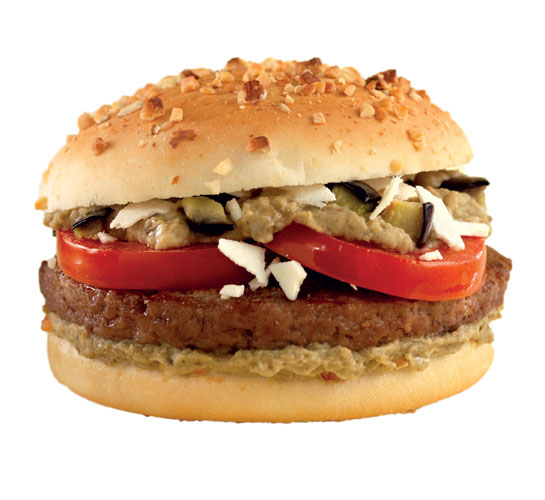
One of two recent McItaly burgers, made with some certified Italian ingredients.
Ever since McDonald’s introduced a pair of Slow Food-inspired McItaly burgers last fall, the company has caused quite a stir on the boot-shaped peninsula. The international chain collaborated with Gualtiero Marchesi, one of Italy’s most renowned chefs — and the only Italian chef to date to receive three Michelin stars — to create the sandwiches. In the process it has also raised big questions about whether a fast food chain can ever truly adopt a Slow Food approach.
Although McDonald’s maintains a fairly consistent core menu around the world, it’s not uncommon for the fast food chain to tailor its restaurants regionally. In Japan, the chain serves ramen noodles, for instance, while the Indonesian menu offers the “McSatay,” and the Indian menu includes something called a “Veggie McMuffin.” Even proud McDonald’s France, otherwise known as “MacDo,” dishes out a popular petit dejeuner-cum-McBreakfast, composed of buttery croissants and cafe au laits, known as “McCafes.”
In Italy, home of the Slow Food movement, the new sandwiches were named Adagio and Vivace (names that Marchesi says represent an integration of two competing philosophies: slow and fast). They were both made with some local and traditional products, such as eggplant, spinach, and the Italian cheese ricotta salata. Several of the products were DOP certified, an acronym that stands for Denominazione di Origine Protetta, a widely recognized certification of regional authenticity.
The two sandwiches were a hit. Due to customer demand, they appeared in the stores for nearly two months longer than the initial three-week “limited time offer.” But their popularity among Italians has also reinvigorated the debate among the Slow Food advocates who criticize the fast food industry’s wanton neglect for local food communities and traditions.
In fact, Slow Food International, a global grassroots organization founded in 1989, made a public statement against the McDonald’s partnership with Marchesi, rebutting the product’s slogan “Fast food has never been this slow” with its own version, “Fast food has never been or will be slow.” Roberto Burdese, president of Slow Food Italy, told the U.K.-based Independent he saw the new menu as “a cynical marketing ploy.”

An ad for an earlier incarnation of the McItaly burger promised Italian beef.
“I don’t really see any kind of change in McDonald’s approach,” says a Slow Food employee who requested that his real name not be used (for understandable reasons). We’ll call him Dario Altieri.
“Their sandwiches are mainly still made with poor raw materials, the working conditions are extremely bad, and even more important their sandwiches are extremely unhealthy. So maybe they’re trying to refresh their image but they’re definitely not changing their approach.”
This is not the first time the Golden Arches and the snail have crossed swords. In fact this most recent clash recalls Slow Food’s own dramatic debut 25 years ago, in response to the McDonald’s entrance into the Italian market. When the chain opened on the Spanish steps in Rome, the newly formed Slow Food took a stance by organizing a highly popular protest in the form of an eat-in in front of the restaurant. And thus this crucial debate for food-loving Italians began.
Although Slow Food differs greatly from McDonald’s in both values and approach to food, it has grown into a major cultural force in the last two-and-a-half decades. And while McDonald’s may now have 419 restaurants in Italy, and employ 14,500 people, Slow Food has over 100,000 members in 150 countries.
To hear chef Marchesi talk about the collaboration, you might think that he was changing McDonald’s from the ground up. In a McEurope press release he said:
… when I began to observe closely, without prejudice, the young, I wondered ‘Where are they going to eat? What do they eat?’ … If it’s true that the haute cuisine changed the taste, now it’s time to present this change to everyone, starting with the youngest. The real news is that with these two sandwiches I opened the doors of the burger kingdom with eggplant and spinach. It’s a big revolution!
Altieri, on the other hand, didn’t see the menu items — or the marketing behind them — as a move toward collaboration. Let alone a revolution.
“It was a sort of counterattack against us,” he says. “It is pretty clear that Slow Food declared war on McDonald’s. The fact is that McDonald’s never did the same, simply because they know they are superior in terms of power and resources.”
That is, until now.
“Keep in mind that in the same month they proposed those sandwiches, they opened a selling point close to Bra [the hometown of Slow Food Founder Carlo Petrini and the organization’s main headquarters],” Altieri adds. These combined efforts, he believes, “can be only considered as a provocation.”
But McDonald’s denies this. Agnes Vadnai, vice president and spokesperson of McEurope, says the plan to include more regional flavors isn’t new.
“A course [of action] began more than three years ago when the company offered recipes closer to the local taste,” she says.
“With the support and endorsement of the Minister of Agriculture, McDonald’s began to make a concerted effort to use local ingredients such as parmigiano reggiano and speck [prosciutto] that were IGP and DOP certified.”
This approach enabled the chain to expand to other parts of Italy. Vadnai says the goal has also “always been to bolster the local agrarian economy and assimilate to Italian food culture and traditions.”
As you might guess, Altieri doesn’t see the burger’s toppings as making a big enough dent in the fast food chain’s overall practices. And he points to the fact that, indeed, “fast can be slow” in some instances.
“I’m pretty sure that we’ve all misunderstood the concept of ‘fast food,’” he says, pointing to the fact that all over the world people have eaten real food on the run, on the streets, while working, etc. As examples he cites arancini — the fried rice balls served on the street in southern Italy — and sushi, which became popular in Japan when more people needed to eat on the go. “The problem,” he adds, “is that this kind of food has been exploited and impoverished by the economic politics of multinationals like McDonald’s.”




